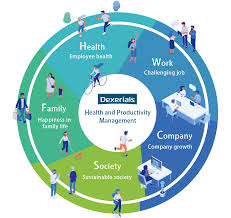Introduction to Health Education in the Workplace
Health education has emerged as a critical component in contemporary business practices, playing a vital role in fostering a supportive work environment that prioritizes employee wellbeing. As organizations increasingly recognize the impact of a healthy workforce on overall productivity and morale, health education becomes essential in cultivating a culture that values wellness. This shift is not merely a trend but rather a necessary strategy for modern companies aiming to enhance both employee satisfaction and business performance.
In recent years, a plethora of studies has illustrated the tangible benefits of implementing health education programs within the workplace. For instance, research indicates that businesses that invest in health and wellness initiatives can experience a significant reduction in healthcare costs and an increase in employee engagement. According to the Global Wellness Institute, companies that prioritize employee wellness witness a 10-20% improvement in productivity, demonstrating a clear return on investment. These statistics underscore the importance of integrating targeted health education into corporate training and development programs.
Moreover, as the workforce evolves, the demand for health education has grown remarkably. Employees are increasingly seeking workplaces that prioritize their health and wellbeing, as evidenced by surveys indicating that nearly 70% of workers consider benefits related to health and wellness pivotal when choosing an employer. By providing comprehensive health education, organizations not only support their employees in making informed health choices but also align company objectives with the wellbeing of their workforce.
In conclusion, the necessity for health education in the workplace is more pronounced than ever. By investing in the health of employees, businesses can create a thriving environment that fosters both individual and organizational success, thereby enhancing overall productivity and workplace morale.
The Importance of Employee Wellbeing
Employee wellbeing encompasses a holistic approach to health, addressing not only the physical aspect but also the mental and emotional dimensions of an individual. This multifaceted concept is increasingly recognized as fundamental to enhancing job satisfaction, boosting morale, and fostering a positive workplace culture. When organizations prioritize employee wellbeing, they set the stage for greater productivity and overall success.
Physical wellbeing is straightforward in its implications; ensuring employees have access to health resources, ergonomic workspaces, and wellness programs directly influences their ability to perform daily tasks effectively. However, the significance of mental and emotional wellbeing cannot be overlooked. Mental health challenges can arise from workplace stressors, including excessive workloads and lack of support. Addressing these issues through mental health resources, such as counseling and stress management workshops, promotes a more resilient workforce.
Moreover, employees who feel psychologically secure—valued and heard—are more likely to contribute positively to team dynamics. This emotional component contributes significantly to how employees interact with one another, collaborate on projects, and solve problems collectively. A strong sense of community and support enhances not only individual performance but also the overall effectiveness of teams. High employee morale often leads to increased job satisfaction, which is linked to lower turnover rates and higher retention of talent within the organization.
In a competitive business landscape, companies must understand that investing in employee wellbeing is not merely a nicety; it is a strategic imperative. By actively promoting initiatives that support the holistic health of their workforce, businesses can cultivate an environment where employees thrive, innovations flourish, and productivity soars. The case for prioritizing employee wellbeing is compelling, as it directly correlates with a positive workplace culture where employees feel engaged and motivated, ultimately driving the company’s success forward.
Benefits of Health Education Programs
Health education programs have become an essential component of workplace wellness initiatives, reflecting a growing recognition of their benefits for both employees and organizations. One of the most significant advantages of implementing health education is the reduction in healthcare costs. By equipping employees with the knowledge and skills to make healthier lifestyle choices, organizations can mitigate chronic diseases, thereby decreasing their overall health insurance expenses. For instance, companies that promote nutritional education and physical wellness typically observe lower medical claims over time.
In addition to cost savings, health education programs contribute to lower absenteeism rates. Employees who participate in health initiatives often report improved physical and mental health, resulting in fewer sick days. Research indicates that organizations with robust health education systems can achieve a reduction in absenteeism by up to 25%. This enhanced attendance directly correlates with improved operational efficiency, as a more present workforce is better equipped to meet company goals.
Moreover, health education fosters enhanced productivity among employees. With better health knowledge, individuals tend to exhibit higher levels of energy and focus, leading to increased engagement in their work. A company that implemented a comprehensive health education program on stress management and mental wellness noticed a 15% boost in overall productivity within its teams. By prioritizing employee well-being through educational initiatives, organizations facilitate a culture of wellness that can increase morale and instigate a sense of community among staff.
As companies recognize the multifaceted benefits of health education programs, many are actively pursuing implementation. Businesses such as Google and Johnson & Johnson have established notable health education platforms that underscore the importance of well-being. These case studies highlight the potential for health education to not only enhance employee welfare but also significantly contribute to the organization’s bottom line.
Key Components of Effective Health Education
Effective health education programs are integral to enhancing employee wellbeing and improving overall productivity within organizations. To maximize their impact, several key components must be considered in the design and implementation of these initiatives.
First and foremost, personalized health assessments play a critical role in crafting relevant health education strategies. By evaluating individual health needs and risks, businesses can better tailor programs to suit their employee demographics. This personalized approach not only engages employees but also fosters a sense of ownership towards their health, promoting long-term behavioral changes.
Diverse learning formats are another essential component of effective health education. Employees may have varying preferences for learning, and utilizing a mix of workshops, seminars, online resources, and interactive tools can enhance accessibility and engagement. For instance, while some employees might thrive in a workshop environment where they can interact with peers, others may prefer solitary online modules that they can complete at their own pace. A blended approach ensures that the information reaches a wide audience and accommodates different learning styles.
Furthermore, consistent follow-up on health education initiatives is vital for reinforcing the knowledge gained during training sessions. Without ongoing support, employees may forget or dismiss essential information over time. Regular check-ins, refresher courses, and provision of additional resources can keep health topics at the forefront of employees’ minds, driving continued participation and interest in their health and wellness.
Finally, crafting engaging and informative content is crucial for any health education program’s success. Utilizing clear language, relatable examples, and visually appealing materials can significantly enhance comprehension and retention. Storytelling elements or real-life case studies can also help illustrate key points, making the subject matter more relatable and memorable for employees.
Integrating Health Education into Company Culture
Health education is an essential component of a thriving business environment, as it not only nurtures employee wellbeing but also enhances overall productivity. To effectively integrate health education into company culture, organizations should adopt various strategies aimed at creating an inclusive and supportive atmosphere where employees feel valued and motivated to participate in health initiatives.
First and foremost, engaging leadership is crucial in laying the groundwork for a successful health education program. Leaders must actively endorse health initiatives and model healthy behaviors themselves, fostering an environment of accountability and commitment to employee wellbeing. By positioning health education as a top priority, organizations can inspire employees to view wellness as a collective value rather than merely individual responsibility. This top-down approach encourages employees to take health education seriously, thereby increasing participation rates and positive outcomes.
Promoting wellness as a shared value among employees involves incorporating health education into daily company operations and activities. This can be achieved through regular wellness workshops, seminars, or health screenings that emphasize the importance of physical, mental, and emotional wellbeing. Furthermore, employers can establish committees or task forces that focus on creating and promoting health-related initiatives. These groups can help tailor health education programs to the specific needs and interests of the workforce, ensuring relevance and engagement.
Creating an environment that supports healthy behaviors is also vital in integrating health education into the corporate culture. Organizations can provide facilities such as gym access, relaxation zones, or nutritious food options in the workplace. Additionally, fostering open communication about health issues and providing resources for mental health services can significantly enhance employees’ willingness to engage in health education opportunities. By establishing these best practices, companies can cultivate a strong culture of health and wellness that benefits both employees and the organization as a whole.
Challenges in Implementing Health Education Initiatives
Implementing health education initiatives within an organization can present a multitude of challenges that may hinder their overall effectiveness. One significant barrier is budget constraints. Many businesses operate on tight financial margins, which can make allocating funds for health education programs difficult. When assessing the costs associated with these programs, organizations must consider not only the initial investment for resources and materials but also ongoing expenses related to training staff, developing content, and maintaining engagement.
Another challenge is the varying levels of readiness among employees to embrace health education initiatives. Employees may differ in their willingness or ability to engage with health programs due to factors such as personal beliefs, lifestyle choices, or previous experiences with health education. This variability can lead to disparities in participation rates, ultimately affecting the program’s overall success. Employers can combat this issue by conducting assessments to gauge the interests and needs of their workforce before rolling out a health education initiative, ensuring that the offered content is relevant and appealing.
Lack of engagement is yet another obstacle that organizations often encounter. Employees may feel overwhelmed by their existing workloads and might not prioritize health programs, viewing them as an additional burden rather than a beneficial resource. To promote higher participation rates, companies can create a supportive environment by integrating health education into existing staff meetings, providing incentives for participating, and fostering a culture where health and wellbeing are valued. Implementing feedback mechanisms allows employees to voice their opinions, helping organizations tailor their health initiatives to better meet employee needs.
By identifying these barriers and employing strategic solutions, organizations can successfully implement health education initiatives that enhance employee wellbeing and, consequently, company productivity. Addressing budget constraints, understanding employee readiness, and fostering engagement are crucial steps in overcoming challenges in health education implementation.
Measuring the Impact of Health Education
Evaluating the effectiveness of health education initiatives within an organization is crucial for understanding their impact on employee wellbeing and overall productivity. Organizations can employ several metrics and key performance indicators (KPIs) to assess the success of these initiatives. These may include employee feedback, health outcomes, engagement levels, and productivity statistics.
One of the primary methods for measuring the impact of health education programs is through employee feedback. Surveys and questionnaires can be distributed to gather insights on employee perceptions regarding the health education initiatives offered. These assessments can help identify which aspects of the program resonate well with employees and which may require improvement. Analyzing employee engagement levels is also essential, as higher participation rates can indicate that employees find the content valuable and relevant.
Health outcomes are another vital metric for evaluating the success of health education initiatives. Organizations can monitor changes in health-related metrics such as employee absenteeism rates, healthcare utilization, and chronic disease prevalence. For instance, a reduction in absenteeism can signify that employees are maintaining better health as a result of the education they received. Tracking these trends over time allows organizations to determine the long-term impact of their health education programs on employee health.
Furthermore, organizations should consider productivity levels as a measure of the effectiveness of health education initiatives. Assessing changes in productivity indicators such as output quality, efficiency, and work quality provides valuable insights. Establishing a correlation between health education initiatives and productivity enhancements can advocate for the continuation and expansion of such programs.
In conclusion, by employing a combination of employee feedback, health outcomes, and productivity metrics, organizations can effectively measure the impact of health education initiatives. These evaluations not only provide a clearer perspective on program effectiveness but also inform necessary adjustments to enhance continuous improvement and achieve optimal results for both employees and the organization as a whole.
Case Studies: Companies Leading in Health Education
In the contemporary business landscape, numerous organizations have recognized the importance of health education in fostering a thriving workplace. Companies such as Google, Johnson & Johnson, and Deloitte serve as prime examples of how effective health education programs can be structured to enhance employee wellbeing and subsequently boost productivity.
Google has pioneered an approach to employee health education that focuses on holistic wellness. They offer a comprehensive wellness program that includes nutrition workshops, fitness classes, and mental health resources. Their proactive measures, which encourage employees to engage in physical activity and maintain healthy dietary practices, have resulted in increased employee satisfaction and lower healthcare costs. By providing employees with accessible health education, Google fosters a culture where wellbeing takes precedence, leading to a more engaged workforce.
Johnson & Johnson’s Health & Wellness program exemplifies successful implementation as well. The company provides employees with regular health assessments and personalized wellness plans. Their initiatives include seminars on smoking cessation, stress management, and chronic disease prevention. Such strategic health education measures have been correlated with improved employee health metrics, decreased absenteeism, and increased productivity. Johnson & Johnson’s emphasis on preventive care showcases the direct link between health education and operational efficiency.
Similarly, Deloitte embraces health education through its “Total Wellbeing” program, which aims to enhance mental, physical, and financial health for its employees. The firm conducts workshops on mindfulness and resilience, along with providing financial literacy education. This multi-faceted approach not only equips employees with valuable life skills but also translates to better job performance and morale. Deloitte’s experience underlines how integrating diverse health education strategies can yield significant organizational benefits.
These case studies illustrate that when organizations effectively incorporate health education into their culture and operations, they foster healthier, more productive work environments. By investing in employee wellbeing through tailored educational initiatives, a company can enhance its overall productivity while nurturing a positive workplace atmosphere.
Conclusion: The Future of Health Education in Business
As organizations increasingly recognize the critical link between employee wellbeing and overall productivity, health education has emerged as a pivotal component of modern business strategies. Throughout this blog post, we have examined the multifaceted role of health education in promoting a healthier workforce, which in turn leads to improved performance and enhanced corporate outcomes. By prioritizing the health education of employees, businesses not only foster a culture of wellness but also minimize healthcare costs, reduce absenteeism, and uplift morale across the organization.
In recent years, there has been a marked shift toward proactive health education initiatives that integrate mental health support, nutrition guidance, and physical wellness programs. Companies are now embracing a holistic approach that encompasses not only traditional health education but also wellness technology, such as mobile health applications and virtual health coaching. These innovations serve to engage employees in their health journeys more effectively, personalizing their experiences and providing accessible resources tailored to individual needs.
Furthermore, the evolving landscape of work, particularly in the wake of the COVID-19 pandemic, has catalyzed a reevaluation of health practices in the workplace. Remote work, flexible schedules, and the rising importance of mental health have necessitated a rethinking of how health education can be delivered. Employers are increasingly seeking innovative solutions, such as online workshops and interactive seminars, to ensure that their employees remain informed and motivated in maintaining their health.
In summary, the future of health education in business is bright, characterized by an ongoing commitment toward employee wellbeing. Organizations that invest in effective health education strategies not only enhance their workforce’s quality of life but also contribute significantly to their overall productivity. Embracing this dynamic and evolving approach will allow businesses to navigate the challenges of the modern work environment while reaping the benefits of a healthier, happier workforce.
How useful was this post?
Click on a star to rate it!
Average rating 0 / 5. Vote count: 0
No votes so far! Be the first to rate this post.

















